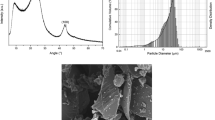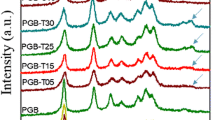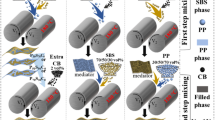Abstract
Developing an effective method for improving the reproducibility of positive temperature coefficient (PTC) effect is of great significance for large-scale application of polymer based PTC composites, owing to its contribution to the security and reliability. Herein, we developed a carbon black (CB)/high density polyethylene (HDPE)/poly(vinylidene fluoride) (PVDF) composite with outstanding PTC reproducibility, by incorporating 1-octyl-3-methylimidazolium bis(trifluoromethylsulfonyl)imide ([OMIm][NTf2]) into the composite. After multiple repeated temperature cycles, the PTC performance of as-prepared material keeps almost unchanged and the varition of resistance at room temperature is less than 7%. Our studies revealed that [OMIm][NTf2] contributes to the improvement of PTC reproducibility in two ways: (i) it acts as an efficient plasticizer for refining the co-continuous phase morphology of HDPE/PVDE blends; (ii) it inhibits the crystallization of PVDF through the dilution effect, leading to more overlaps of the volume shrinkage process of HDPE and PVDF melt which results in the decrease of interface gap between HDPE and PVDF. This study demonstrated that ionic liquids as the multifunctional agents have great potential for improving the reproducibility in the application of the binary polymer based PTC composites.
Similar content being viewed by others
References
Liu, Y.; Zhang, H.; Porwal, H.; Tu, W.; Evans, J.; Bilotti, E. Universal control on pyroresistive behavior of flexible self-regulating heating devices. Adv. Funct. Mater. 2017, 27, 1702253.
Wang, L.; Chen, L. X.; Song, P.; Lu, Y. J.; Qiu, H.; Zhang, Y. L.; Kong, J.; Gu, J. W. Fabrication on the annealed Ti3C2Tx MXene/epoxy nanocomposites for electromagnetic interference shielding application. Compos. Part B Eng. 2019, 171, 111–118.
Chen, J. W.; Cui, X. H.; Sui, K. Y.; Zhu, Y. T.; Jiang, W. Balance the electrical properties and mechanical properties of carbon black filled immiscible polymer blends with a double percolation structure. Compos. Sci. Technol. 2017, 140, 99–105.
Yılmaz, O. C.; Sen, I.; Gurses, B. Q.; Ozdemir, O.; Cetin, L.; Sarıkanat, M. The effect of gold electrode thicknesses on electromechanical performance of Nafion-based ionic polymer metal composite actuators. Compos. Part B Eng. 2019, 165, 747–753.
Radzuan, N. A. M.; Zakaria, M. Y.; Sulong, A. B.; Sahari, J. The effect of milled carbon fibre filler on electrical conductivity in highly conductive polymer composites. Compos. Part B Eng. 2017, 110, 153–160.
Chen, Z.; Hsu, P. H.; Lopez, J.; Li, Y. Z.; To, J. W. F.; Cui, Y.; Wang, C.; Andrews, S. C.; Liu, J.; Cui, Y.; Bao, Z. N. Fast and reversible thermoresponsive polymer switching materials for safer batteries. Nat. Energy 2016, 1, 15009.
Kang, H. S.; Sim, S.; Shin, Y. H. A numerical study on the light-weight design of PTC heater for an electric vehicle heating system. Energies 2018, 11, 1276.
Song, P.; Liang, C. B.; Gu, H. B.; Wang, L.; Qiu, H.; Kong, J.; Gu, J. W. Obviously improved electromagnetic interference shielding performances for epoxy composites via constructing honeycomb structural reduced graphene oxide. Compos. Sci. Technol. 2019, 181, 107698.
Liu, Y.; Zhang, H.; Porwal, H.; Tu, W.; Wan, K. N.; Evans, J.; Newton, M.; Busfield, J. J. C.; Peijs, T.; Bilotti, E. Tailored pyroresistive performance and flexibility by introducing a secondary thermoplastic elastomeric phase into graphene nanoplatelet (GNP) filled polymer composites for self-regulating heating devices. J. Mater. Chem. C 2018, 6, 2760–2768.
Wang, X.; Sparkman, J.; Gou, J. H. Electrical actuation and shape memory behavior of polyurethane composites incorporated with printed carbon nanotube layers. Compos. Sci. Technol. 2017, 141, 8–15.
Deng, H.; Lin, L.; Ji, M. Z.; Zhang, S. M.; Yang, M. B.; Fu, Q. Progress on the morphological control of conductive network in conductive polymer composites and the use as electroactive multifunctional materials. Prog. Polym. Sci. 2014, 39, 627–655.
Xu, H. Positive temperature coefficient effect of polymer nanocomposites. In Polymer nanocomposites, Huang, X.; Zhi, C. Eds. Springer: Cham., 2016, p. 83–110.
Bae, S. H.; Layek, R. K.; Lee, S. H.; Kuila, T.; Kim, N. H.; Lee, J. H. Effects of the reduction of PAni-coated oxidized multiwall carbon nanotubes on the positive temperature coefficient behaviors of their carbon black/high density polyethylene composites. Polym. Test. 2016, 50, 83–93.
He, L. X.; Tjong, S. C. Facile synthesis of silver-decorated reduced graphene oxide as a hybrid filler material for electrically conductive polymer composites. RSC Adv. 2015, 5, 15070–15076.
Zhang, R.; Tang, P.; Shi, R.; Cheng, T.; Bin, Y.; Hu, S. Improved electrical heating properties for polymer nanocomposites by electron beam irradiation. Polym. Bull. 2018, 75, 2847–2863.
Tang, P.; Zhang, R.; Chen, Z.; Yang, B.; Bin, Y. Effect of y-ray irradiation on the microstructure and self-heating property of carbon fiber/polyethylene composite films. Compos. Part A 2015, 78, 174–180.
Dang, Z. M.; Li, W. K.; Xu, H. P. High performance hybrid carbon fillers/binary-polymer nanocomposites with remarkably enhanced positive temperature coefficient effect of resistance. J. Appl. Phys. 2009, 106, 024913.
Liang, C. B.; Song, P.; Qiu, H.; Zhang, Y. L.; Ma, X. T.; Qi, F. Q.; Gu, H. B.; Kong, J.; Cao, D. P.; Gu, J. W. Constructing interconnected spherical hollow conductive networks in silver platelets/reduced graphene oxide foam/epoxy nanocomposites for superior electromagnetic interference shielding effectiveness. Nanoscale 2019, 11, 22590–22598.
Hu, J.; Liu, L. Q.; Xie, Y. Y.; Wu, L. M. Facile synthesis of thermalresponsive P(NIPAM-S)/SiO2 hybrid hollow spheres and their controllable release property for fragrance. Polym. Chem. 2013, 4, 3293–3299.
Chen, L.; Hou, J. R.; Chen, Y. W.; Wang, H. J.; Duan, Y. X.; Zhang, J. M. Synergistic effect of conductive carbon black and silica particles for improving the pyroresistive properties of high density polyethylene composites. Compos. Part B Eng. 2019, 178, 107465.
Qu, Y.; Zhang, W.; Dai, K.; Zheng, G.; Liu, C.; Chen, J.; Shen, C. Tuning of the PTC and NTC effects of conductive CB/PA6/HDPE composite utilizing an electrically superfine electrospun network. Mater. Lett. 2014, 132, 48–51.
Lai, F.; Wang, B. B.; Zhang, P. Enhanced positive temperature coefficient in amorphous PS/CSPEMWCNT composites with low percolation threshold. J. Appl. Polym. Sci. 2019, 136, 47053.
Di, W. H.; Zhang, G.; Peng, Y.; Zhao, Z. D. Two-step PTC effect in immiscible polymer blends filled with carbon black. J. Mater. Sci. 2004, 39, 695–697.
Wei, Y.; Li, Z.; Liu, X.; Dai, K.; Zheng, G. Q.; Liu, C. T.; Chen, J. B.; Shen, C. Y. Temperature-resistivity characteristics of a segregated conductive CB/PP/UHMWPE composite. Colloid Polym. Sci. 2014, 292, 2891–2898.
Zha, J. W.; Li, W. K.; Liao, R. J.; Bai, J.; Dang, Z. M. High performance hybrid carbon fillers/binary-polymer nanocomposites with remarkably enhanced positive temperature coefficient effect of resistance. J. Mater. Chem. A 2013, 1, 843–851.
Chan, C. M.; Feng, J. Carbon Black-Filled immiscible blends of poly(vinylidene fluoride) and high density polyethylene: the relationship between morphology and positive and negative temperature coefficient effects. Polym. Eng. Sci. 1999, 39, 1207–1215.
Chan, C. M.; Feng, J. Double positive temperature coefficient effects of carbon black-filled polymer blends containing two semicrystalline polymers. Polymer 2000, 41, 4559–4565.
Narkis, M.; Mironi-Harpaz, I. Thermoelectric behavior (PTC) of carbon black-containing TPX/UHMWPE and TPX/XL-UHMWPE blends. J. Polym. Sci. Part B: Polym. Phys. 2001, 39, 1415–1428.
Xie, L.; Zhu, Y. T. Tune the phase morphology to design conductive polymer composites: a review. Polym. Compos. 2018, 39, 2985–2996.
Bin, X.; Xu, C.; Agari, Y.; Matsuo, M. Morphology and electrical conductivity of ultrahigh molecular weight polyethylene/low molecular weight polyethylene/carbon black composites prepared by gelation/crystallization from solutions. Colloid Polym. Sci. 1999, 277, 452–461.
Zhang, X.; Zheng, X. D.; Zou, H. Z.; Zheng, X. F.; Liu, Z. Y.; Yang, W.; Yang, M. B. Two-step positive temperature coefficient effect with favorable reproducibility achieved by specific “island-bridge” electrical conductive networks in HDPE/PVDF/CNF composite. Compos. Part A 2017, 94, 21–31.
Jeon, J.; Lee, H. B. R.; Bao, Z. Flexible wireless temperature sensors based on Ni microparticle-filled binary polymer composites. Adv. Mater. 2013, 25, 850–855.
Vidal, L.; Riekkola, M. L.; Canals, A. Ionic liquid-modified materials for solid-phase extraction and separation: a review. Anal. Chim. Acta 2012, 15, 19–41.
Xu, Y.; Xu, H.; Zheng, Q. Influence of ionic liquid on glass transition, dynamic rheology, and thermal stability of poly(methyl methacrylate)/silica nanocomposites. J. Appl. Polym. Sci. 2019, 136, 48007.
Xing, C. Y.; Li, J. Y.; Yang, C. M.; Li, Y. J. Local grafting of ionic liquid in poly(vinylidene fluoride) amorphous region and the subsequent microphase separation behavior in melt. Macromol. Rapid Commun. 2016, 37, 1559–1565.
Wang, C.; Liao, W. P.; Wang, M. L.; Lin, C. C. Miscible blends of syndiotactic polystyrene and atactic polystyrene. Part 2. Depolarized light scattering studies and crystal growth rates. Polymer 2004, 45, 973–981.
Meng, Q. J.; Li, W. J.; Zheng, Y. S.; Zhang, Z. C. Effect of poly(methyl methacrylate) addition on the dielectric and energy storage properties of poly(vinylidene fluoride). J. Appl. Polym. Sci. 2010, 116, 2674–2684.
Berhan, L.; Sastry, A. M. Modeling percolation in high-aspect-ratio fiber systems. I. Soft-core versus hard-core models. Phys. Rev. E 2007, 75, 041120.
Balberg, I.; Anderson, C. H.; Alexander, S.; Wagner, N. Excluded volume and its relation to the onset of percolation. Phys. Rev. B 1984, 30, 3933–3943.
Grunberg, L.; Nissan, A. H. Mixture law for viscosity. Nature 1949, 164, 799–800.
Stefanie, B.; Andreas, S.; Sven, H.; Ralf, H. Morphology formation in PC/ABS blends during thermal processing and the effect of the viscosity ratio of blend partners. Materials 2016, 9, 659.
Pötschke, P.; Paul, D. R. Formation of co-continuous structures in melt-mixed immiscible polymer blends. J. Macromol. Sci. Polym. Rev. 2003, 1, 87–141.
Zha, J. W.; Wu, D. H.; Yang, Y.; Wu, Y. H.; Li, R. K. Y.; Dang, Z. M. Enhanced positive temperature coefficient behavior of the high-density polyethylene composites with multi-dimensional carbon fillers and their use for temperature-sensing resistors. RSC Adv. 2017, 7, 11338–11344.
Seo, M. K.; Rhee, K. Y.; Park, S. J. Influence of electro-beam irradiation on PTC/NTC behaviors of carbon blacks/HDPE conducting polymer composites. Curr. Appl. Phys. 2011, 11, 428–433.
Martins, P.; Lopes, A. C.; Lanceros-Mendez, S. Electroactive phases of poly(vinylidene fluoride): determination, processing and applications. Prog. Polym. Sci. 2014, 39, 683–706.
Acknowledgments
This work was financially supported by the National Natural Science Foundation of China (Nos. 51803103 and 21873059) and Taishan Mountain Scholar Foundation (Nos. TS20081120 and tshw20110510).
Author information
Authors and Affiliations
Corresponding author
Rights and permissions
About this article
Cite this article
Chen, L., Wu, X., Zhang, XF. et al. Enhanced Reproducibility of Positive Temperature Coefficient Effect of CB/HDPE/PVDF Composites with the Addition of Ionic Liquid. Chin J Polym Sci 39, 228–236 (2021). https://doi.org/10.1007/s10118-020-2475-x
Received:
Accepted:
Published:
Issue Date:
DOI: https://doi.org/10.1007/s10118-020-2475-x




